Systematics of the Protohermes xanthodes species-group in eastern Asia (Megaloptera: Corydalidae)
Abstract
A new species-group of the dobsonfly genus Protohermes is proposed, the Protohermes xanthodes species-group. Three species from eastern Asia belonging to the new species-group are redescribed and illustrated. Phylogenetic relationships among the species in this group, as well as the biogeography of these species, are discussed on the basis of a cladistic analysis.
INTRODUCTION
The Asian dobsonfly genus Protohermes is one of the most species-rich genera within the subfamily Corydalinae. It includes up to 40 described species, which are predominantly distributed in the Oriental region. Adult Protohermes are characterized by a yellowish body with various blackish marks on the head and pronotum, wings usually with several yellowish or whitish marks, forewing with a three-branched 1A, and a posteriorly incised male ninth sternum. The male tenth tergite varies generally from an elongate band and flattened valve, to a short subcylindrical or claviform tube. Early revisions of the genus were made by European neuropterologists (van der Weele 1910; Lestage 1927; Kimmins 1948). This genus, together with Neurhermes Navás, were established as a well-supported monophyletic group according to cladistic analyses (Glorioso 1981; Penny 1993; Contreras-Ramos 1998). The group was thought to be a sister group to the remaining genera within the Corydalinae by Penny (1993), or a sister group to the remaining Corydalinae genera except Chloroniella Esben-Petersen with the most primitive phylogenetic status by Contreras-Ramos (1998). Recent studies of the systematics of Protohermes have been carried out by Hayashi (1989a,b, 1990), Yang (1985), Yang and Yang (1988), and Liu and Yang (2005, 2006a,b).
Previously, two Protohermes species-groups, the P. changninganus species-group and the P. davidi species-group, have been recognized (Liu & Yang 2005, 2006b). The P. costalis species-group was recognized as the third species-group by X. Liu, F. Hayashi and D. Yang (unpubl. data, 2006). In the present paper, a fourth species-group, the Protohermes xanthodes species-group, is proposed, comprising the species P. xanthodes, P. grandis, and P. immaculatus. All three species are keyed, redescribed, and reillustrated herein. The first record of the genus Protohermes from Korea is included, as well as a discussion of the phylogeny and biogeography of the P. xanthodes species-group.
MATERIALS AND METHODS
Preparation of specimens
Specimens were collected mostly using light traps in mountainous regions at sites close to clean running water. Genitalic preparations were made by clearing the apex of the abdomen in a saturated KOH solution for 8–10 h. The apex of the abdomen was transferred to glycerin for further dissection and examination, then moved to fresh glycerin and stored in a microvial pinned below the specimen.
The specimens for the present study are deposited at the Entomological Museum of the China Agricultural University (CAU), Beijing; the Institute of Zoology, Chinese Academy of Sciences (IZCAS), Beijing; the Shanghai Entomological Museum, Chinese Academy of Sciences (SEMCAS), Shanghai; and Fumio Hayashi’s personal collection (HC), Tokyo, Japan.
Morphological terminology generally follows Glorioso (1981) except for the terminology for the tenth abdominal segment, which follows Contreras-Ramos (1998).
Cladistic analysis
For the analysis, three Protohermes species, P. infectus (McLachlan, 1869), P. changninganusYang and Yang, 1988, and P. nigerYang and Yang, 1988, were selected as the outgroups. This is because P. infectus and P. changninganus are considered to have a basal status in Protohermes. Also, P. niger is considered to be the most primitive species of the P. costalis species-group.
Nine adult morphological characters were numerically coded for all three species of the P. xanthodes species-group and the three outgroups, which are listed below. All the characters presently selected were obtained from the male genitalia except the first two, which were obtained from the head and wings. The data matrix is given in Table 1. The character state coding is: 0, plesiomorphic; 1–3, apomorphic.
| Taxon | Characters | ||||||||
|---|---|---|---|---|---|---|---|---|---|
| 1 | 2 | 3 | 4 | 5 | 6 | 7 | 8 | 9 | |
| P. infectus | 0 | 1 | 0 | 0 | 0 | 0 | 0 | 0 | 0 |
| P. changninganus | 0 | 1 | 0 | 0 | 1 | 0 | 0 | 0 | 0 |
| P. niger | 1 | 1 | 0 | 0 | 2 | 1 | 0 | 0 | 0 |
| P. grandis | 1 | 0 | 1 | 1 | 3 | 1 | 0 | 1 | 0 |
| P. immaculatus | 1 | 0 | 1 | 1 | 3 | 1 | 0 | 1 | 0 |
| P. xanthodes | 1 | 0 | 0 | 0 | 3 | 1 | 1 | 0 | 1 |
- 0, Plesiomorphic state; 1–3, apomorphic state.
- 1
Lateral ocelli: close to median ocellus, 0; widely apart from median ocellus, 1.
- 2
Forewing with costal areas: hyaline, 0; dark or marked by several dark stripes, 1.
- 3
Male ninth sternum: narrower than ninth tergum, 0; wider than ninth tergum, 1.
- 4
Male ninth sternum with median portion: not inflated, 0; distinctly inflated, 1.
- 5
Male tenth tergite: simple digitiform, 0; long band-like, 1; subcylindrical, 2; claviform, 3.
- 6
Male tenth tergite: without setal tuft, 0; with setal tuft, 1.
- 7
Ninth gonostylus: slender, 0; thick, 1.
- 8
Male tenth sternite with median portion: simple, 0; enlarged and somewhat modified, 1.
- 9
Male tenth sternite with lateral lobes: nearly membranous, 0; moderately sclerotized, 1.
The present cladistic analysis was performed using paup* version 4.0b10 (Swofford 2002) by using heuristic parsimony analysis, with 1000 random stepwise additions of taxa (TBR branch swapping) under ACCTRAN optimization, characters unordered and of equal weight, MulTrees option in effect. Bootstrap values for clades were calculated in 1000 replicates using a general heuristic search, with branches with bootstrap values <50% collapsed. Bremer’s decay index was calculated using Autodecay version 4.0 (Eriksson 1998) and paup* version 4.0b10.
TAXONOMY
Genus Protohermes van der Weele
Protohermes van der Weele (1907): 243. Type species Hermes anticus Walker (1853): 205, original designation.
Allohermes Lestage (1927): 100. Type species Protohermes davidi van der Weele (1909): 254, original designation. (Synonymized by Glorioso 1981.)
General characters. Body medium to large sized (forewing length 28–65 mm). Body pale yellow to yellowish brown, sometimes blackish brown.
Diagnosis. Head robust, postocular spines present or absent; vertex often with several dark marks. Posterior pair of ocelli close to or widely apart from median ocellus, median ocellus usually flattened and transverse. Antenna subserrate, approximately as long as the head plus prothorax. Clypeal margin entire. Labrum subtriangular.
Prothorax longer than wide, pronotum with various patterns of dark marks. Wings slightly smoky brown to blackish brown, often with several yellowish or whitish marks, showing distinct specific variations. Rs 8–11-branched, last branch bifurcate or trifurcate; 6–14 crossveins between R1 and Rs; M1+2 4–9-branched, M3+4 2–4-branched; 1A three-branched.
Male ninth tergum often shorter than wide, with anterior margin incised in an arched manner; ninth tergum broad, often with V-shaped, arched, or trapezoidal posterior incision; tenth tergite slender digitiform, short claviform, short subcylindrical, flattened valvate, or elongated band-like; ninth gonostylus unguiform; tenth sternite often arched, with pair of lateral lobes digitiform or tubercle. Female eighth sternum strongly sclerotized, often produced posteriorly; ninth gonocoxite membranous, flattened; ninth gonostylus short and digitiform, articulated with gonocoxite; tenth tergite often incised from side by cerci, forming one dorsal and one ventral lobe.
Protohermes xanthodes species-group
Diagnostic characters. Head and pronotum yellow to yellowish brown, with several blackish marks. Ocelli widely apart. Wing slightly smoky brown, usually with yellowish marks; costal areas without dark stripes. Male tenth tergite short, claviform, with one tuft on inner subdistal portion. Male tenth sternite wide, with elongate lateral lobes. Female genitalia simple, without sac-like lobes on ninth abdominal segment.
Remarks. This species-group appears to be closely related to the P. costalis species-group by having similar widely separated ocelli and the male tenth tergite bearing a tuft of setae, but it can be easily separated from the latter by the claviform male tenth tergite and the simple female genitalia without lateral lobes. In the P. costalis species-group, the male tenth tergite is subcylindrical with a more or less incised tip, and the female genitalia bear a pair of sac-like lateral lobes on the ninth abdominal segment.
Key to species of the P. xanthodes group
- 1
Male ninth gonostylus thick (Fig. 19); male tenth sternite moderately sclerotized, simple, with spinous tip (Fig. 21); female eighth sternum with posterior margin feebly produced (Fig. 22) P. xanthodes Navás
- –
Male ninth gonostylus slender (4–10, 11–17); male tenth sternite feebly sclerotized, median portion enlarged, with tip rounded (4–10, 11–17); female eighth sternum with posterior margin strongly produced 4–10, 11–17) 2
- 2
Large-sized (forewing length 33–65 mm); wings with several distinct yellowish marks; male tenth tergite with apex produced into two processes (Fig. 5); female eighth sternum with posterior margin medially incised (Fig. 10) P. grandis (Thunberg)
- –
Small-sized (forewing length 26–39 mm); wings with small indistinct yellowish marks; male tenth tergite with simple apex (Fig. 12); female eighth sternum with posterior margin truncate (Fig. 17) P. immaculatus Kuwayama
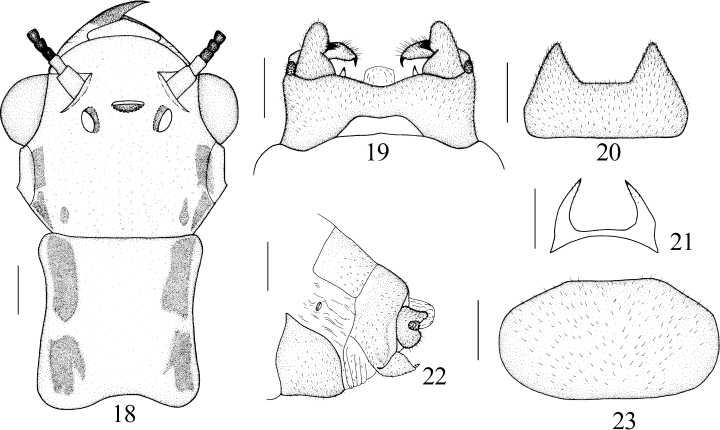
Protohermes xanthodes Navás. 18 Male head and prothorax, dorsal view; 19 male genitalia, dorsal view; 20 male ninth sternum, ventral view; 21 male tenth sternite, ventral view; 22 female genitalia, lateral view; 23 female eighth sternum, ventral view. Scale lines: 1.0 mm.
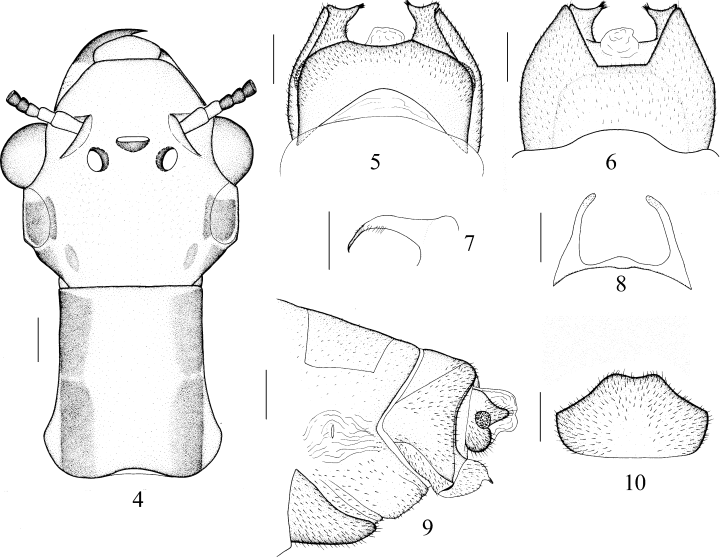
Protohermes grandis (Thunberg). 4 Male head and prothorax, dorsal view; 5 male genitalia, dorsal view; 6 male genitalia, ventral view; 7 male ninth gonostylus, caudal view; 8 male tenth sternite, ventral view; 9 female genitalia, lateral view; 10 female eighth sternum, ventral view. Scale lines: 1.0 mm.
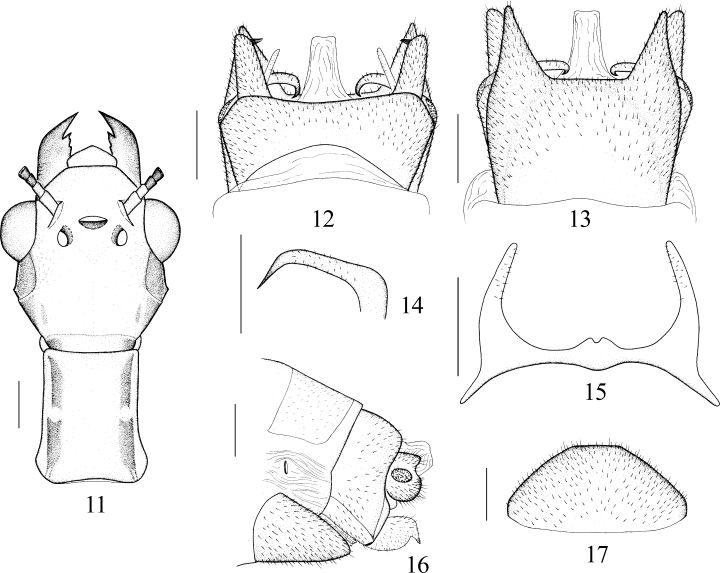
Protohermes immaculatus Kuwayama. 11 Male head and prothorax, dorsal view; 12 male genitalia, dorsal view; 13 male genitalia, ventral view; 14 male ninth gonostylus, caudal view; 15 male tenth sternite, ventral view; 16 female genitalia, lateral view; 17 female eighth sternum, ventral view. Scale lines: 1.0 mm.
Protohermes grandis (Thunberg) 1–3, 4–10)
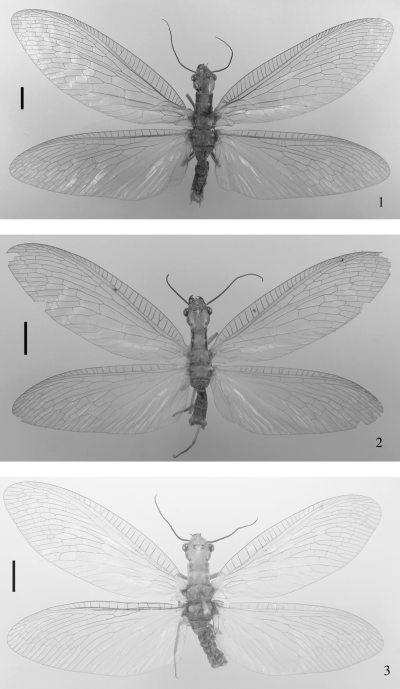
Adults of Protohermes spp. 1Protohermes grandis (Thunberg) (male). 2Protohermes immaculatus Kuwayama (male). 3Protohermes xanthodes Navás (male from Korea). Scale lines: 5.0 mm.
Hemerobius grandis Thunberg (1781): 28.
Diagnosis. Head with three pairs of black marks laterally on vertex; pronotum with two pairs of black vittae on each side; male tenth tergite short, claviform, with apex produced into two processes, and inner process bearing one setal tuft.
Male. Body length 24–43 mm; forewing length 33–51 mm, hindwing length 29–46 mm.
Head yellowish brown, with two pairs of large subquadrate and one pair of small suboval black marks on lateral portion of vertex; postocular spine absent. Compound eyes brown, ocelli yellow with black inner margin. Median ocellus rather flattened and transverse; posterior pair widely apart, distance between them about twice the width of median ocellus but shorter than that between antennal sockets. Antenna black, scape and pedicel yellowish brown. Mouthparts yellowish brown; maxillary and labial palpi with distal two segments infuscate; mandible with distal half blackish brown.
Prothorax yellowish brown; pronotum with two pairs of narrow black vittae near lateral margins, somewhat connected at midlength. Meso- and metathorax yellowish brown, dorsally with lateral portion brown. Thoracic pilosity yellow, much longer on meso- and metathorax. Legs yellowish brown with short, dense, yellowish setae; apices of tibiae wide, grayish brown, tarsi grayish brown, tarsal claws reddish brown. Forewings pale smoky brown, with pair of large and small yellowish marks at base, one large and three small yellowish marks at middle, and one round yellowish mark at apical 1/3. Hindwings pale smoky brown except basal half hyaline, with round yellowish mark at middle and at apical 1/3, respectively. Veins brown, with veins much paler in anal areas and yellowish marks. Rs ten- or 11-branched, last branch bifurcate; eight or nine crossveins between R1 and Rs; M1+2 five- or six-branched, M3+4 two-branched; 1A three-branched.
Abdomen brown with venter and genitalia yellow. Ninth tergum (Fig. 5) transversely widened, with arched anterior and posterior margins. Ninth sternum (Fig. 6) much broader than ninth tergum; posterior margin deeply incised, trapezoidal, forming pair of acutely produced processes; central portion apparently inflated. Ninth gonostylus (Fig. 7) slender, unguiform, slightly curved dorsad. Tenth tergite (Figs 5,6) short, claviform, with apex produced into two processes, its inner process bearing one setal tuft. Tenth sternite (Fig. 8) arched, medially elevated at anterior and posterior margins; lateral lobes elongated, digitiform, slightly incurved.
Female. Body length 25–45 mm; forewing length 42–65 mm, hindwing length 38–53 mm. Color similar to male.
Female eighth sternum (Figs 9,10) strongly sclerotized, subtriangular in lateral view, subtrapezoidal in ventral view, with posterior margin slightly incised, forming pair of roundly produced processes; ninth gonocoxite broad, ventro-distal portion concave, with small digitiform processes at tip; tenth tergite short, with posterior margin triangularly incised from side, leaving one subtriangular dorsal lobe and one semicircular ventral lobe.
Specimens examined. Japan: 1♂ 3♀♀ (HC), Akan-gawa, Akan, Hokkaido Prefecture (Pref.), 5.viii.1990, R. Kuranishi; 1♂ 2♀♀ (HC), Akabira, Hokkaido Pref., 20.vii and 1.viii.1996, S. Hara; 1♀ (HC), Uryu, Hokkaido Pref., 1.viii.1996, S. Hara; 1♂ (HC), Syakotan, Hokkaido Pref. 1997, reared from larva, F. Hayashi; 1♀ (HC), Oguni-gawa, Iwate Pref., 16.viii.1983, S. Uchida; 4♂♂ 2♀♀ (HC), Natori-gawa, Miyagi Pref., reared from larvae, F. Hayashi; 1♂ (HC), Aizu-tajima, Fukushima Pref., 22.vii.1986, G. Mori; 3♂♂ 1♀ (HC), Irihirose-mura, Kitauonuma-gun, Niigata Pref., 27.vi.1998, M. Yamamoto; 4♀♀ (HC), Nasu-machi, Tochigi Pref., 28.vii.1996, K. Waki; 1♂ (HC), Ino-kawa, Chiba Pref., 29.v.1987, K. Fukuyama; 1♂ 2♀♀ (HC), Ino-kawa, Chiba Pref., 17, 29.viii.1989, K. Fukuyama; 1♂ 1♀ (HC), Yozawa-gawa, Itsukaichi, Tokyo, 13.vii.1990, S. Uchida; 1♀ (HC), Yozawa-gawa, Itsukaichi, Tokyo, 2.vii.1990, S. Uchida; 1♂ (HC), Todori-machi, Hachioji, Tokyo, 1.vii.2001, F. Hayashi; 1♀ (HC), Setagaya-ku, Tokyo, 21.v.1951, N. Iwasaki; 13♂♂ 6♀♀ (HC), Morito-gawa, Miura Peninsular, Knagawa Pref., F. Hayashi; 3♂♂ 3♀♀ (HC), Yataro-gawa, Susugaya, Kanagawa Pref., F. Hayashi; 1♀ (CAU), Matsuda-machi, Kanagawa Pref., 7.vi.1997, S. Hara; 1♀ (HC), Doshi-mura, Tsuru-gun, Yamanashi Pref., 31.vii.1993, K. Waki; 1♂ (HC), Uenohara, Nirasaki, Yamanashi Pref., 28.vi.1994, K. Kariya; 1♂ (HC), Hosaka-machi, Nirasaki, Yamanashi Pref., 7.vii.1995, K. Kariya; 1♂ (HC), Fujimi-kogen, Nagano Pref., 14.vii.1988, K. Hatta; 1♀ (HC), Oppara, Kamo, Gifu Pref., 30.vii.1973, F. Kamiya; 1♀ (HC), Ohara, Ono-gun, Gifu Pref., 21.vi.1997, M. Yamamoto; 1♀ (HC), Miyawaki, Mikata-gun, Hyogo Pref., 16.viii.1989, N. Yamakawa; 5♂♂ 2♀♀ (1♂ in CAU, others in HC), Gunke-machi, Tottori Pref., 17.vii.1996, M. Yamamoto; 1♂ (HC), Nakamura-shi, Kochi Pref., 1.vii.1995; 1♂ 1♀ (HC), Ajimu-machi, Usa-gun, Oita Pref., 9.viii.1984, T. Torii; 1♀ (HC), Jigoku, Aso-gun, Kumamoto Pref., 6.viii.1987, E. Matsui; 1♀ (HC), Mount Ichifusa, Kumamoto Pref., 31.vii.1989, E. Matsui; 1♀ (HC), Ue, Kuma-gun, Kumamoto Pref., 23.vii.1987, E. Matsui; 4♂♂ 5♀♀ (HC), Minami-gawa, Miyazaki Pref., reared from larvae, F. Hayashi; 6♂♂ 5♀♀ (HC), Sasu-gawa, Tsushima Island, Nagasaki Pref., reared from larvae, F. Hayashi; 8♂♂ 7♀♀ (HC), Shiratani-gawa, Yaku-shima Island, Kagoshima Pref., reared from larvae, F. Hayashi; 1♂ (SEMCAS), no detailed locality, 2.vi.1920.
Distribution. Japan (Hokkaido, Okushiri Island, Honshu, Sado Island, Oki-Togo Island, Shikoku, Kyushu, Tsushima Island, Amakusa Islands, Yakushima Island, Tanegashima Island; Hayashi 2005).
Remarks. This species is common in Japan and easily distinguished by the large body size and the bright yellowish wing color pattern. It appears to be closely related to P. immaculatus because the two species share a slender male ninth gonostylus and a female eighth sternum with the posterior margin strongly produced, but can be easily separated by the unique male tenth tergite with two processes at the tip. In P. immaculatus, the male tenth tergite is simple without any additional process (Kuwayama 1964).
Protohermes immaculatus Kuwayama (1–3, 11–17)
Protohermes immaculatus Kuwayama (1964): 25.
Diagnosis. Body small-sized; vertex with three pairs of black marks; occiput with pair of black marks; mandible mostly blackish brown; wings with small indistinct yellowish marks; male tenth tergite simple, claviform, with one inner setal tuft on subdistal portion.
Male. Body length 19–26 mm; forewing length 26–33 mm, hindwing length 24–29 mm.
Head yellow, vertex with three pairs of black marks on lateral portion, marks of anterior pair large, subquadrate, those of postero-outer pair subtriangular, and those of postero-inner pair smallest and suboval; postocular spine present, feebly developed. Occiput with pair of black marks on each side. Compound eyes blackish brown, ocelli yellow with black inner margin. Median ocellus rather flattened and transverse; posterior pair widely apart, distance between them as long as that between antennal sockets but less than twice the width of median ocellus. Antenna black, with scape and pedicel yellow. Mouthparts yellow; galea, maxillary, and labial palpi much darker; mandible mostly blackish brown, with proximal inner portion much paler.
Prothorax yellow; pronotum with pair of narrow black vittae near each lateral margin. Meso- and metathorax yellow, dorsally with lateral portion much darker. Thoracic pilosity yellow, much longer on meso- and metathorax. Legs yellow with short, dense, yellowish setae; tarsi mostly grayish yellow, tarsal claws reddish brown. Wings pale smoky brown without any marks, forewing with small indistinct yellowish marks around stem of Cu1. Veins pale brown, with veins pale yellow in anal areas. Rs 9 to 11-branched, last branch bifurcate; 5–8 crossveins between R1 and Rs; M1+2 five- or six-branched, M3+4 two-branched; 1A three-branched.
Abdomen blackish brown. Ninth tergum (Fig. 12) transversely widened, with arched anterior margin and shallowly incised posterior margin. Ninth sternum (Fig. 13) much broader than ninth tergum; posterior margin deeply incised, trapezoidal, forming pair of acutely produced processes; central portion apparently inflated. Ninth gonostylus (Fig. 14) slender, unguiform, strongly curved dorsad. Tenth tergite (Figs 12,13) simple, claviform, as long as ninth tergum, bearing inner setal tuft on subdistal portion. Tenth sternite (Fig. 15) arched, medially elevated at anterior and posterior margins, posterior margin with one small median incision; lateral lobes elongated, digitiform, directed dorsad and slightly incurved.
Female. Body length 20–30 mm; forewing length 31–39 mm, hindwing length 28–35 mm. Color similar to male.
Female eighth sternum (Figs 16,17) strongly sclerotized, subtriangular in lateral view, subtrapezoidal in ventral view, with truncate posterior margin; ninth gonocoxite broad, ventro-distal portion concave, with small digitiform processes at tip; tenth tergite short, with posterior margin roundly incised from side, leaving a thick subtriangular dorsal lobe and a semicircular ventral lobe.
Specimens examined. Japan: 2♀♀ (HC), Sumiyo, Amami-oshima Island, central Ryukyus, 22.vi.1987, K. Uesugi; 5♂♂ 6♀♀ (1♂ in CAU, others in HC), Kawauchi-gawa, Amami-oshima Island, reared from larvae, F. Hayashi; 4♂♂ 7♀♀ (1♀ in CAU, others in HC), Asato-gawa, Amami-oshima Island, reared from larvae, F. Hayashi; 2♂♂ 1♀ (HC), Kametoku-gawa, Tokunoshima Island, central Ryukyus, reared from larvae, F. Hayashi; 1♂ 1♀ (HC), Akirigami-gawa, Tokunoshima Island, reared from larvae, F. Hayashi; 1♀ (HC), Mikyo, Tokunoshima Island, 8.vii.1989, H. Karube; 4♂♂ 1♀ (HC), Shirase-gawa, Kume-jima Island, central Ryukyus, reared from larvae, F. Hayashi.
Distribution. Japan (Amami-oshima Island, Tokunoshima Island, Kume-jima Island).
Remarks. This species is the smallest known Protohermes species. As noted in the remarks for P. grandis given above, P. immaculatus appears to be related to P. grandis, but can be easily distinguished because the wings have small and indistinct yellowish marks.
Protohermes xanthodes Navás 1–3, 18–23)
Protohermes xanthodes Navás (1913): 427.
Protohermes rubidus Stitz (1914): 201. syn. nov.
Protohermes martynovae Vshivkova (1995): 24. syn. nov.
Diagnosis. Body medium-sized; vertex with three pairs of black marks; wings with yellowish marks; male tenth tergite simple, claviform, with inner median margin incised, bearing one inner setal tuft on subdistal portion; male ninth gonostylus strongly developed with one apical claw.
Male. Body length 23–35 mm; forewing length 31–42 mm, hindwing length 28–37 mm.
Head yellow to yellowish brown, vertex with three pairs of black marks on lateral portion, marks of anterior pair large and subquadrate, those of the postero-outer pair subtriangular, and those of the postero-inner pair smaller and suboval; postocular spine present, feebly developed. Compound eyes blackish brown, ocelli yellow with black inner margin. Median ocellus flattened and transverse; posterior pair widely apart, distance between them nearly as long as that between antennal sockets and twice the width of median ocellus. Antenna black, with scape and pedicel yellow. Mouthparts yellow; mandible with apical half blackish brown.
Thorax yellow to yellowish brown; pronotum with a pair of black vittae near each margin; meso- and metanotum pale brown laterally. Thoracic pilosity yellow, much longer on meso- and metathorax. Legs yellow with short, dense, yellowish setae; tibiae and tarsi pale brown, tarsal claws reddish brown. Forewings pale smoky brown, with a large yellowish mark at base, three to four small yellowish marks at middle, and a small, round, and yellowish mark at apical 1/3. Hindwings pale smoky brown except basal half hyaline, with a round yellowish mark at the middle and apical 1/3, respectively. Veins pale brown, but pale yellow in yellowish marks and basal half of hindwing. Rs ten-branched, last branch bifurcate or trifurcate; 11 crossveins between R1 and Rs; M1+2 five- or six-branched, M3+4 four-branched; 1A three-branched.
Abdomen yellow to brown. Ninth tergum (Fig. 19) nearly rectangular, with trapezoidal anterior margin and shallowly incised posterior margin. Ninth sternum (Fig. 20) much narrower than ninth tergum; posterior margin deeply incised, trapezoidal, forming a pair of acutely produced processes; central portion feebly inflated. Ninth gonostylus (Fig. 19) thick, directed inward, with one slender distal claw. Tenth tergite (Fig. 19) simple claviform, slightly shorter than ninth tergum, with inner median margin incised, bearing one inner setal tuft on subdistal portion. Tenth sternite (Fig. 21) simple, arched; lateral lobes moderately sclerotized, digitiform, directed dorsally and slightly incurved, with spinous apex.
Female. Body length 37–52 mm; forewing length 45–51 mm, hindwing length 40–47 mm. Color similar to male.
Female eighth sternum (Figs 22,23) strongly sclerotized, subtrapezoidal in lateral view, suboval in ventral view, with truncate posterior margin; ninth gonocoxite subtriangular, with small digitiform processes at tip; tenth tergite short, with posterior margin roundly incised from side, leaving one thick subtriangular dorsal lobe and one semicircular ventral lobe.
Specimens examined. China: 1♀ (IZCAS), Liaoning, Caohekou, 18.vii.1958; 1♂ (CAU), Shandong, Taian, Xishan, 20.vi.1962; 1♀ (CAU), Beijing, Pinggu, 1976; 1♀ (CAU), Beijing, Campus of Beijing Agricultural University, 1976; 1♀ (CAU), Beijing, Miyun, 9.vi.1960; 1♀ (CAU), Beijing, Miaofengshan, 24.vi.1955, L. S. Zhao; 1♂ (CAU), Beijing, Xiangshan, 20.vi.1980, C. H. Yang; 2♂♂ (CAU), Beijing, Dingjiatan, 28/30.vii.1960, F. S. Li; 6♀♀ (IZCAS), Beijing, Sanpu, 25.vii.1967, J. M. Zhao; 1♂ (IZCAS), Beijing, Badaling, 700 m, 25.vi.1964, C. B. Liao; 1♀ (IZCAS), Beijing, Changping, 9.vii.1959; 3♀♀ (IZCAS), Beijing, Sanpu, 22/24.vii.1964, C. B. Liao; 1♀ (IZCAS), Beijing, Sanpu, 9.vii.1964, Q. Zhou; 1♀ (IZCAS), Beijing, Sanpu, 5.viii.1964, Q. Zhou; 1♂ (CAU), Beijing, Fangshan, Hebeigongshe, 6.vi.1960, C. K. Yang; 1♀ (CAU), Beijing, Miaofengshan, 10.viii.1964, X. M. Cai; 1♂ 1♀ (CAU), Shanxi, Daning, Xifeng, 1980; 5♀♀ (CAU), Shanxi, Taigu, 26/30.vii.1964, C. H. Yang; 1♂ (CAU), Gansu, Wenxian, Gaoloushan 1700 m, 7.viii.1960, C. K. Yang; 1♀ (CAU), Gansu, Dianbu, Lazikou, 1700 m, 12.viii.1980, C. K. Yang; 1♂ 3♀♀ (IZCAS), Gansu, Chengxian, Feilongxia, 1020 m, 4.vii.1999, T. L. He; 1♂ (CAU), Shannxi, Ankang, 10.vii.1981; 1♂ (CAU), Shannxi, Yan-an, viii.1981; 1♀ (CAU), Shannxi, Hanzhong, v.1981; 1♂ (CAU), Shannxi, Y. Zhou; 1♀ (IZCAS), Shannxi, Foping, 900 m, 27.vi.1999, J. Yao; 1♂ 7♀♀ (IZCAS), Shannxi, Foping, 890 m, 26.vi.1999, T. L. He; 2♀♀ (IZCAS), Shannxi, Foping, 900 m, 27.vi.1999, C. D. Zhu; 1♂ 3♀♀ (CAU), Henan, Xishan, Huangshian, 1000 m, 16.vii.1998, X. C. Shen and Y. D. Ren; 2♀♀ (CAU), Henan, Huanglianshu, 1600 m, 6.vi.2000, X. C. Shen and Y. D. Ren; 9♂♂ 16♀♀ (CAU), Henan, Shangcheng, Huangbaishan, 14.vii.1999, X. C. Shen and Y. D. Ren; 1♀ (IZCAS), Anhui, Shitai, 1.vi.1975; 1♂ (CAU), Hubei, Wuxia, Guandukou, 8.vi.1951, B. L. Lu; 1♂ (CAU), Hubei, Shennongjia, Songbai, 22.vi.1977, S. L. Liu; 2♂♂ 2♀♀ (IZCAS), Hunan, Dong-an, 3/10.v.1954; 1♂ (CAU), Hunan; 1♀ (CAU), Jiangxi, Shangrao, 30.iv.1973, C. K. Yang; 1♂ 1♀ (IZCAS), Jiangxi, Yiyang, 12/13.v.1975, Y. W. Zhang; 1♂ (IZCAS), Jiangxi, De-an, Pengshanlinchang, 13.v.1980; 7♂♂ 5♀♀ (CAU), Zhejiang, Lishui, v.17/vi.25. 1982; 1♂ (CAU), Fujian, v.1990; 1♂ 4♀♀ (CAU), Guangdong, Wengyuan, v.1974, R. Z. Wu; 1♂ (CAU), Guangxi, Guilin, 150 m, 8.vi.1984; 5♂♂ 9♀♀ (CAU), Guangxi, Lingchuan, Lingtian, 275 m, 4/7.vi.1984, F. S. Li and D. Yang; 3♀♀ (CAU), Guangxi, Guilin, Yanshan, 7/8.v.1964; 2♀♀ (IZCAS), Guangxi, Guilin, Yanshan, 13/16.v.1963, C. G. Wang; 1♀ (IZCAS), Guangxi, Jinxiu, Luoxiang, 200 m, 15.v.1999, X. Z. Zhang; 1♀ (IZCAS), Guangxi, Xing-an, Maoershan, 400 m, 12.vii.1985; 1♂ (CAU), Guizhou, 3.vii.1964; 3♂♂ (CAU), Chongqing, Beibei, x.1955; 1♂ 1♀ (CAU), Sichuan, Ya-an, 1973; 1♂ (CAU), Sichuan, Ya-an, viii.1984; 1♀ (IZCAS), Sichuan, Pengshui, 750 m, 9.vii.1989, L. L. Yang; 1♀ (IZCAS), Sichuan, Pengshui, 750 m, 13.vii.1989, X. C. Zhang. Korea: 2♂♂ (1 in CAU, 1 in HC), Yongsuchon River, Yongsuri, Changaum, Kijiang-gun, reared from larvae, F. Hayashi.
Distribution. China (Anhui, Beijing, Gansu, Guangdong, Guangxi, Guizhou, Hebei, Henan, Hubei, Hunan, Jiangxi, Liaoning, Shandong, Shanxi, Shaanxi, Sichuan, Yunnan, Zhejiang); Korea (Kijiang-gun); Russia (south Primorskij).
Remarks. This species was described by Navás (1913) based on one female specimen from Yunnan (Dali), with only one figure of the pronotum in his original description, which has been difficult to use in identification. However, this species’ identity was clarified after the redescriptions by Tjeder (1937, 1954). Currently, P. xanthodes is the most common of the Protohermes xanthodes species-group species in China, with a wide distribution. Protohermes xanthodes is herein recorded from Korea for the first time, with specimens that appear paler and smaller than those from China.
Protohermes rubidus was established by Stitz in 1914 based on specimens from China (Qingdao, Shandong). Banks (1940) mentioned that this species might be the same as P. xanthodes. In the present paper, in accordance with the original illustrations of the male genitalia of P. rubidus, which are the same as those of P. xanthodes, we have placed P. rubidus as a junior synonym of P. xanthodes.
According to the original illustrations of the male genitalia, P. martynovaeVshivkova, 1995, seems to be within the range of variation of P. xanthodes. For this reason, this species is considered to be one of the north-eastern populations of P. xanthodes.
RESULTS AND DISCUSSION
A heuristic search resulted in only one most parsimonious tree (length (L) = 11, consistency index (CI) = 1.00, retention index (RI) = 1.00). The most parsimonious tree is shown in Figure 24; Bremer’s decay index and bootstrapping values over 50% are also represented.

The most parsimonious tree for all species of the Protohermes xanthodes species-group (L = 11, CI = 1.00, RI = 1.00). Numbers below squares correspond to characters as described in the text: numbers above squares correspond to states. Bremer’s decay index and bootstrap values >50% (1000 replicates) are indicated in the circles at the nodes (Bremer’s decay index on the left side of the diagonal line, bootstrap values on the right side of the diagonal line).
The P. xanthodes species-group formed a monophyletic group supported by immaculate costal areas of forewings (character 2: 0) and a claviform male tenth tergite (character 5: 3). Its sister relationship with the P. costalis species-group is supported by three synapomorphic characters: the widely separated ocelli (character 1:1), a subcylindrical male tenth tergite (character 5: 2), and a male tenth tergite bearing one setal tuft (character 6: 1). Within the P. xanthodes group, the sister relationship between P. grandis and P. immaculatus is supported by a broader male ninth sternum with strongly inflated median portion (characters 3: 1, 4: 1) and a highly modified male tenth sternite with the median portion enlarged (character 8: 1). The thick male ninth gonostylus (character 7: 1) and the moderately sclerotized lateral lobes of the male tenth sternite (character 9: 1) represent the autapomorphic characters of P. xanthodes.
Considering the distributions of the P. xanthodes species-group (Fig. 25), P. xanthodes is widely distributed in China, extending northward to the Russian Far East and Korea. Protohermes grandis is restricted to Palaearctic Japan, and P. immaculatus is restricted to only some islands of the central Ryukyus, which belong to southern Japan. Both these species are recognized to be distributed along the West Pacific Island Arc, which might have been separated from the Asian mainland during the transgression of the Pacific Ocean after the mid-Pleistocene (Zhang 1999). Therefore, speciation of P. grandis and P. immaculatus might take place due to the vicariance between the Asian mainland and the West Pacific Island Arc.
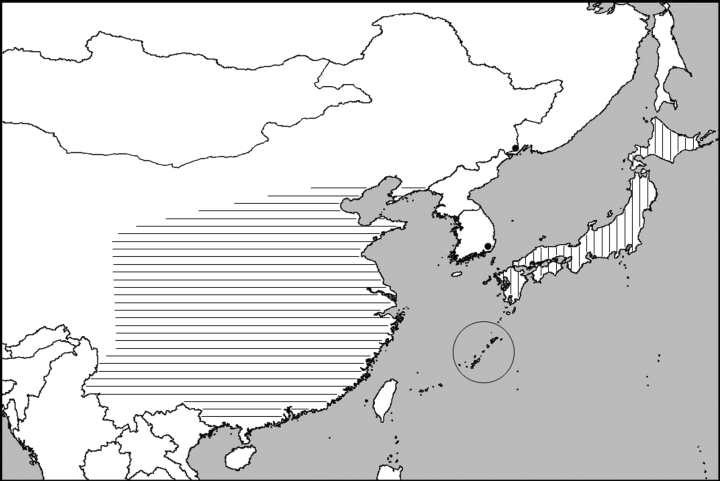
Distribution map of the Protohermes xanthodes species-group. (●) and (), P. xanthodes; (), P. grandis; circled area, P. immaculatus.
ACKNOWLEDGMENTS
We are grateful to Dr Xianwei Liu (Shanghai) and Dr Weinian Zhang (Shanghai) for the loan of several specimens deposited in the Entomological Museum of Shanghai, Chinese Academy of Science, and to several Japanese colleagues for providing useful materials. This research was supported by the National Natural Science Foundation of China (30370174, 30225009).




